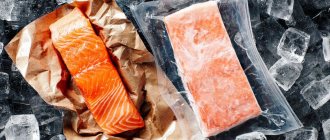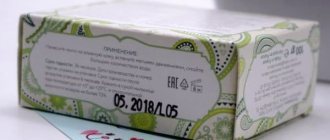Fish is a universal product that is available in almost any refrigerator. It is stewed, fried, dried, salted, smoked and made into incredibly tasty “he” according to Korean recipes. However, storing fish involves a number of subtleties that must be observed to extend the shelf life relative to the type of processing. This is exactly what this article will be about.
Why you need to know how to store fish
Fish contains the amino acid histidine. It is most abundant in salmon, tuna, mackerel, and herring. If stored improperly, microflora develops, which converts histidine into histamine with its enzymes. Increasing the level of this amine does not affect the taste properties. A person cannot determine the histamine content by smell or taste.
Histamine is normally found in the body and performs certain functions. However, in high doses it causes poisoning, clinical signs similar to allergies. Large amounts of histamine can lead to irreversible consequences.
The state regulates the maximum permissible concentrations of histamine, and inspection services constantly monitor the market. But even if the fish served on the store counter is benign in terms of histamine, improper storage leads to its accumulation.
It is important to know!
Heat treatment does not affect histamine levels.
Effect of cold on quality
This method has an advantage over other storage methods. Today it is one of the most significant and promising areas in the fishing industry.
The superiority of cooling over other forms of processing lies in the maximum conservation of biologically useful components and taste of fish during the preservation process.
Such a product is in great demand in markets all over the world, and the production area of its cooling belongs to the fast-growing group.
In this article you will find all the information about storing milk.
Storage conditions and periods according to GOST
Chilled
GOST for chilled fish stipulates that it should be stored at a temperature from 0 to -2 °C.
The deadlines are as follows:
| Fishing period | For large | For small fish (haddock, capelin, etc.) |
| from October to March | 12 days | 9 days |
| from April to September | 10 days | 7 days |
Pond fish packed without ice can be stored at a temperature not exceeding 6 °C for no more than 2 days.
Ice cream
Storage of frozen fish is regulated at a temperature not higher than -18 ᵒC.
Shelf life of frozen product according to GOST
All other uncut fish are stored for no more than 4 months, cut - 3 months.
If the storage temperature is not higher than -25 °C, then the period is increased by 2 months.
Hot smoked
For this type of product, GOST regulates the following terms:
• at a temperature of 2–6 °C – no more than 48 hours; • from -2 to 2 °C – 72 hours; • at -18 °C – 30 days.
Cold smoked
For such a product, temperature parameters are defined from -5 to 0 °C, and the period is no more than 2 months. At the same temperature, vacuum-packed fish can be stored for no more than 20 days. At temperatures not higher than -8 °C, the period increases to 30 days.
If the fish is from inland waters, then store it for up to 40 days at a temperature of -2 to 1 °C.
Salty
If fish is stored in barrels with brine (7% salt solution) at a temperature from -8 to 4 ᵒC, then the terms are as follows:
• lightly salted – 4 months; • medium salting – 6 months; • strong salting – 9 months.
We recommend reading: Herring in the refrigerator: simple recipes for long-term storage.
Standards for storing fish in a refrigerator
The microorganisms present in fish affect the period of its storage, and the refrigeration cabinet inhibits the activity of bacteria and lengthens the storage time. However, the temperature of +5 C maintained in ordinary household units is not suitable for long-term preservation of product freshness, since it requires maintaining a temperature regime of -2...0 ̊C. Due to these temperature conditions, fish products will remain fresh in a classic refrigerator for 24 hours.
It is possible to set a lower temperature, but for other products this thermometer mark is too low. To solve this problem, it is recommended to first place the fish in an airtight container filled with ice, and only then put it in the refrigerator on the shelf. This will preserve freshness for 1-2 days longer than when stored in normal refrigerator compartment conditions.
It is much easier when the unit has a BioFresh or BioFresh-Plus section. In such a zone, fish products can be preserved for two days, since the temperature in the section is maintained at 0 °C. In a BioFresh-Plus container at a temperature of -2 °C, fish can stay for up to four days.
How to choose fresh
To avoid mistakes, buy only live fish. Even a child can recognize her - she moves her tail, fins, and jaws. If the fish is dead (not alive), refuse to purchase.
Of course, there are a number of signs that determine how long ago the fish was caught. But the current environmental situation is so bad that even a laboratory is sometimes unable to determine its freshness.
If the fish shows no signs of vital activity, then pay attention to:
- Appearance. The surface must be clean. The scales are held tightly, intact and without damage. The consistency is dense (don’t be afraid to press the carcass with your finger).
- Gills. The rich red color and lack of odor indicate freshness. Some species have pink gills and a specific smell - this is also the norm. If the reservoir is polluted, then this indicator can be ignored.
- Smell. Specific fishy, without any extraneous notes. A faint smell of sludge is acceptable. If it is sour or unpleasant, the fish is not fresh.
How does the cooling process occur?
Based on regulatory provisions, chilled fish specimens when interacting with ice are preserved for 7-12 days . It all depends on the seasonal catch and its size.
Unfortunately, the established time frame does not make it possible to fully provide the population of the Russian Federation, located at a distance from fishing grounds, with chilled products.
Such restrictions do not allow the use of industrial processing of this product.
The existing problem was resolved by a team of Russian specialists.
They proposed their own version of improving the cooling process, increasing the time savings to 25 days at temperatures from -1 to -3 degrees Celsius.
The basis was the food addition of multifunctional compounds “Varex-7” and table salt with certain structural forms of ice.
During testing, this food complex proved the necessity of its presence.
Small scaly pieces of ice come into close contact with the fish without creating large air spaces. They stop the proliferation of harmful microbes, bacteria, enzymes as much as possible, and also temporarily localize lipid oxidation.
A varied concentration of additions allows the ice to regulate the temperature of the chilled product. the highest quality is maintained throughout the entire storage time .
Today this process has become even more advanced. a cooling gel using the Varex-7 complex and table salt .
The frozen solution completely covers the fish, creating an outer cocoon for it.
Then it penetrates into the internal cavity , enveloping the organs and cooling the entire anatomical structure.
This makes it possible to quickly reduce temperature values close to cryoscopic ones and maintain them until they reach the customer.
Cooling gel makes it possible to increase the saving time up to 40 days .
From this article you will learn how to properly store honey.
How to store raw food: terms, conditions, packaging
At home, store fish only in the refrigerator and for no more than a day. You don’t know how long it was stored before it came into your kitchen. Don't risk your health.
How to prepare (does it need to be gutted?)
The fish should go into the refrigerator gutted. Ideally: brought, gutted, placed in the refrigerator, or better yet, cooked immediately.
In a refrigerator
Bags and paper are already a thing of the past. A plastic container is ideal. In this case, there is no need to choose a place and look at the “neighbors” on the shelf.
When figuring out at what temperature chilled and gutted fish is stored, it should be taken into account that a household refrigerator cannot create 2 °C. At higher temperatures it is dangerous to keep the product for a long time. If the carcass is cut into portions and washed, then it can be stored for no more than 24 hours.
There is no way to cook fish within 24 hours - put it in the freezer!
In the freezer
For freezing, the product can be wrapped in plastic bags or paper, but it is better to put it in a container. Only gutted fish should be frozen.
If the carcass is divided into portions, then it is advisable to pack each separately. In this case, you can remove only the part that is necessary for cooking.
The freezer compartment of a home refrigerator does not always provide -18 °C. Therefore, when deciding how long fish can be stored in a household freezer, you should limit yourself to 2 months.
After defrosting
In order for defrosting to be successful, fish from the freezer is placed in the refrigerator and not allowed to completely defrost. The preparation of the dish begins when it is still slightly frozen and not a single microbe has begun to multiply.
Note to the hostess
Fish should not be re-frozen - it will lose its integrity during subsequent cooking.
Without a refrigerator, on the road
Nowadays there are thermal bags and thermal bags, so the transportation process is easier. If you don’t have a bag or package, you can use ice or plastic bottles with frozen water. But remember, when the ice completely melts, the fish carcass begins to heat up and microorganisms multiply - this is dangerous.
If safety conditions cannot be ensured, refuse transportation. The product will be spoiled.
We recommend reading: Food thermal bags: 5 uses you didn’t know about.
In a vacuum
If the fish is vacuum packed, there is only one piece of advice - follow the instructions on the label. Only the manufacturer knows how and for how long such a product can be stored.
The duration of storage of a product in a vacuum depends on the preservatives with which it is treated and on the conditions during packaging
What we definitely do not recommend doing and why:
Defrost in hot or warm water
- Absolutely not! Simultaneously with defrosting, the process of denaturation (destruction of structure) of the protein and preparation of the product begins. The fish absorbs water, releasing its own juice and microelements and eventually falls apart
Defrost in the microwave
- The picture is similar to defrosting in hot water, but still this is a more acceptable option in the most extreme cases
Thaw fish at room temperature
- Of course it's not fatal. If you are limited in time, but you still need to prepare dinner for the whole family and the only way out is to take it out of the refrigerator in the morning and leave it on the table, then leave it. But keep in mind that after some time the process of reproduction of harmful bacteria will begin on the fish, and the longer it lies idle at room temperature, the more harmful this process will be
- In this case, we recommend cooking even fish that has not completely thawed - most likely, its structure will suffer, but the fish will be as fresh as possible
Refreeze fish
- If you suddenly changed your mind or didn’t have time to cook the fish, and then put it back in the freezer (or defrosted it at room temperature and left it in the refrigerator for tomorrow) - you know what we will say about this. Definitely NO! The fish will lose a huge part of all its taste and beneficial properties, it will become dry, hard, tasteless, and its fibers will be destroyed as much as possible and in the end you will get not a fish, but a washcloth
How to store live
Live fish is an ideal product. However, if caught in polluted waters, it can be dangerous.
If the fish is alive, then expiration dates are not established even by GOST. However, the conditions of transportation and sale are regulated. Particular attention is paid to the fact that:
- Live fish should be stored in water with a temperature difference between the tank and the reservoir of no more than 4 °C;
- the aquatic system must be aerated and supplied with running water.
Do you know that…
The difference between live and dead fish is that the former shows signs of vital activity and its price is correspondingly higher.
At home
Live fish are stored in water. In this case, the liquid must be completely changed every day.
During the cold season, low water temperatures can be maintained by nature itself. In summer, it is better to lower the container with fish into the basement.
Fishing
Experienced fishermen, in order to deliver the fish home fresh, cover it with nettles. This is a dubious method. At high ambient temperatures, nettle does not help.
If there is a lot of fish and the journey is long, it must be gutted at the fishing site, washed and sprinkled with salt.
How to defrost fish
Fish that has been frozen must defrost correctly. It is optimal when the carcasses or their parts thaw on their own - first in the refrigerator compartment, and only then at room temperature (+18...+25 ̊C). When you plan to use a fish product for soup or as part of another dish, it is permissible to use a semi-thawed product. When planning to bake or fry, the seafood must be completely defrosted. It is forbidden to refreeze seafood - if it is completely thawed, it must be heat treated.
How to store the finished product: terms, conditions, containers
Even if you bought fresh fish and cooked it quickly, the shelf life of the dish is not long.
The time allotted for consuming a ready-made fish dish is literally measured in hours due to the rapid development of microflora
Boiled, baked, fried
Any cooked and uneaten fish, once cooled, should be placed in a container and transferred to the refrigerator. Shelf life 12 hours. If you don't eat it, freeze it.
If the fish soup has been cooked, do not pour it into a container and do not remove the fish. Place the container in which the dish was prepared in the refrigerator. After storing in the refrigerator, you need to bring it to a boil and only then start eating.
Smoked
A cold or hot smoked product brought home must be eaten within 48 hours. A household refrigerator does not allow you to store smoked fish for longer.
If there is a lot of fish, wrap it in two plastic bags or put it in a container and put it in the freezer. If frozen, the product can be stored for up to 30 days.
It is important to know!
Modern smoking means new technologies. The fish is soaked in a special solution - “liquid smoke” - and dried. This product should not be given to children and people with chronic diseases.
Sun-dried, dried
When buying such fish, give preference only to labeled products. The manufacturer himself determines the shelf life and indicates it on the packaging. Conditions of detention are also described. After opening the package, the product must be eaten.
Storage of dried fish depends on the amount of fat in the product. This is difficult to determine visually. The less fatty the fish, the longer its shelf life:
- fatty (more than 10%) can only be stored in the freezer at -18 °C for up to 5 months;
- non-greasy - in a dark, dry, ventilated area for up to 2 months.
Dried in the freezer can be stored for up to 5 months, at a temperature of 0 to 6 °C - up to two.
To prevent dried fish from drying out, you can wrap it in parchment, put it in a container with a tight-fitting lid and put it in a dark, cool place
Salty
Storing salted fish depends on the salt content in it. The saltier the product, the longer it can be stored. However, production times of 4, 6, 9 months apply only to large freezers.
At home, salted fish can be:
- place in a 7% salt solution and refrigerate for up to 10 days (in this case, it does not matter how much salt was there before);
- wrap it in a plastic bag and put it in the freezer for a month;
- cut into portions (without bones), place tightly in a container, fill with sunflower oil to the top and store in the refrigerator for up to 10 days, in the freezer for up to a month.
Tip of the day
Red fish is stored as indicated by the manufacturer on the label. Only he knows the preservatives with which the product was processed. If there are no instructions, place in the freezer for no more than a month.
Storing dried fish
Cured, dried and dried fish can be stored for up to one year at a temperature of -5...-8 C. There are several household options for maintaining the freshness of dried fish products:
- The carcass is wrapped in paper or newspapers and left cool.
- A hot candle is placed in a large jar along with the carcass and the container is closed with a lid. When the oxygen runs out, the candle goes out, and the fish is edible for 2-3 months.
- Dried fish can be frozen, then it maintains its own freshness for up to 10 months.
Attention! When dried fish product is stored in a plastic bag, it deteriorates much more quickly, so you should not keep such a delicacy in cellophane.
Signs of a spoiled product and what to do with it
If the fish seems suspicious, refuse to purchase, even if the expiration date has not expired. If doubt arises during storage at home, discard the product. Remember that they are easy to poison.
Signs of the onset of damage may include changes:
- colors;
- consistency;
- smell.
Do you know that…
Some peoples prefer to eat fish “with flavor” and feel good at the same time. This is not our option. The body adapts (produces enzymes) to the lifestyle over the years, and this is fixed at the genetic level. If such a dish is not a traditional food product for you, it is better not to risk it.
What is the shelf life?
Based on Art. 472-473 of the Civil Code of the Russian Federation, the period of time during which, subject to storage conditions, fish is suitable for consumption is its shelf life.
Both the conditions under which fish and fish products should be stored and their expiration dates are regulated by GOSTs depending on the type of fish products.
Based on Decree of the Government of the Russian Federation dated June 16, 1997 No. 720, the manufacturer, when establishing the period during which fish is suitable for consumption, must be guided by the norms of legislative acts, not forgetting the protection of consumer rights.
This period can be determined as follows:
- number of days (months, year), starting from the date of fish production;
- a specific date after which consuming the product becomes hazardous to human health.
Shelf life and shelf life are different concepts that differ from each other. Fish will become unfit for food if the expiration date expires. If the shelf life expires, the products change their properties, but remain edible.
How long can salted herring be stored?
The shelf life of herring depends on the conditions in which the product is located
| Storage conditions | Saving period |
| No freezing | 2-3 hours |
| In brine (refrigerator) | 30 days |
| Lightly salted in brine | 7 days |
| In brine (cellar) | 10 days |
| In beer brine | 1 Week |
| In vegetable oil | 4 days |
| Closed vacuum packaging | Up to 35 days |
| In an opened vacuum container | No more than 2 days |
| Opened preserves | 1 day |
| In the marinade | 4 days |
Salted herring in the freezer
If the goal of saving is to prepare pickled herring for future use, then use the freezer. The period of preservation of the taste and beneficial qualities of the product does not exceed 6 months.
Be sure to read:
Storing minced meat in the refrigerator and freezer
Herring can be preserved in different forms:
- in a jar in pieces, with vegetable oil,
- in a dense polyethylene container,
- in a vacuum
- in a polyethylene bag with brine.
Important! The defrosting process must take place in the refrigerator compartment. Do not defrost the product in a microwave oven or by adding boiling water.
Preparation for storage
All products must be processed before storage. We must remember the old truth - a fish rots from the head. Therefore, first of all, the head is separated from the carcass, and all other entrails are also removed. You can cut the carcass at the time of purchase. The seller will do this more professionally, and the shelf life of the carcass without head and entrails will increase.
- Before storing fresh fish in the refrigerator, it should be washed thoroughly. Of course, we are talking about a gutted carcass (you cannot send a whole fish for storage).
- Then wipe dry from the outside and inside with a napkin or disposable towel until there is no moisture left at all.
There is no need to wash fish fillets before storing them.
Storing on a refrigerator shelf
Fresh fish is best stored at a temperature of 0°C -+2°C. These conditions can be recreated in the coldest part of the refrigerator. What temperature, on which shelf, in your refrigerator model can be found in the instructions for it.
Refrigerators that do not have a special temperature-controlled zone can be equipped with containers with ice and cut up carcasses can be kept there. Ice is poured into a container, fish (fillets) are placed on it, and then ice cubes are poured on top. With this storage method, it is important to check the condition of the ice so that it does not melt. If this happens, the carcasses will end up in water and quickly spoil.
At +2°C -+5°C, the shelf life of gutted fresh fish will be 2 days.
It is not advisable to keep fish in a bag or refrigerator. This reduces shelf life to 8 - 12 hours. This bag should only be used to transport this product.
Key indicators of freshness
The skin of an ordinary fish with a natural color of its surface should not have any damage . Dark red gills may change to pink. The eyes should remain protruding and transparent.
The elastic structure of meat fibers allows only slight weakening, but in no case flabby . There should be no ice crust on the carcass. Fresh products have an exclusively natural smell.
Chilled fish may have red spots on damaged scales.
This is a consequence of hemorrhages during catching or transportation. White spots on the skin indicate that the product has been frozen for a long time.
At the point of sale, almost all representatives of aquatic fauna, except for the sturgeon group, may have a sourish odor in their gills. It is easy to get rid of it by washing them with running water.
Tips for the hostess
There are some tricks and tips that would be useful for any housewife to know:
- The purchase of fish should be carried out at specialized retail outlets, where all the necessary conditions for preserving fish products are provided.
- Herring must be kept in an airtight container, as it has a strong odor.
- It is prohibited to store products in metal containers. The best containers for this type of product are containers made of ceramics, glass, and food-grade plastic.
- The optimal type of packaging is paper without printing. She will absorb the juices. Otherwise, the growth of pathogenic bacteria in the fish juice is possible.
- When cutting into portions, do not remove the skin. It will protect the fish from drying out.
- It is not advisable to freeze balyk, canned food, or caviar.
- Herring is stored only in a dark room. When exposed to sunlight, the product acquires a bitter taste.
- It is important to follow the rule of product proximity. Meat, cheese, and eggs should not be placed next to fish.
It is necessary to take a responsible approach to the issue of storing such a perishable product as fish. Shelf life depends on the type of fish, the method of its preparation and storage conditions.
Compliance with all safety standards and regulations will not only help you prepare a delicious dish, but will also protect you from possible food poisoning.
Determining the freshness of goods arriving at their destination
Transported products can be chilled in the form of whole uneviscerated carcasses or with the gills removed. In addition to the above, fish with completely cleaned insides or cut into small pieces can be transported chilled. Well-chilled and fresh fish always has a certain list of characteristics. You can suspect that seafood was transported with violations if the product does not meet the following criteria:
- There is no unpleasant odor other than the characteristic fishy one.
- The color of the carcasses is completely natural - there are no suspicious areas with a modified color.
- The surface of the fish is intact, without damage or contamination.
- When pressed, the meat is firm or slightly soft, but not falling apart, or flabby.
- The eyes of fresh chilled fish are transparent and bulging.
- If the gills are not removed, they are colored pinkish or reddish and covered with colorless transparent mucus.
How to find out if a product is damaged?
Particular attention should be paid to the smell, which cannot be confused with anything else. Take a closer look at the damaged goods :
- gray or black gills;
- a dent appears ;
- there is a rotting smell ;
- tissues are separated from bones;
- the scales should not stick to your hands;
- in the salmon family, the red color changes to gray;
- When immersed in water, fresh fish will be at the bottom, spoiled fish will be on top.
Fish with similar characteristics must be disposed of immediately .
Under what conditions and where rice cereals are stored, read the next article.











